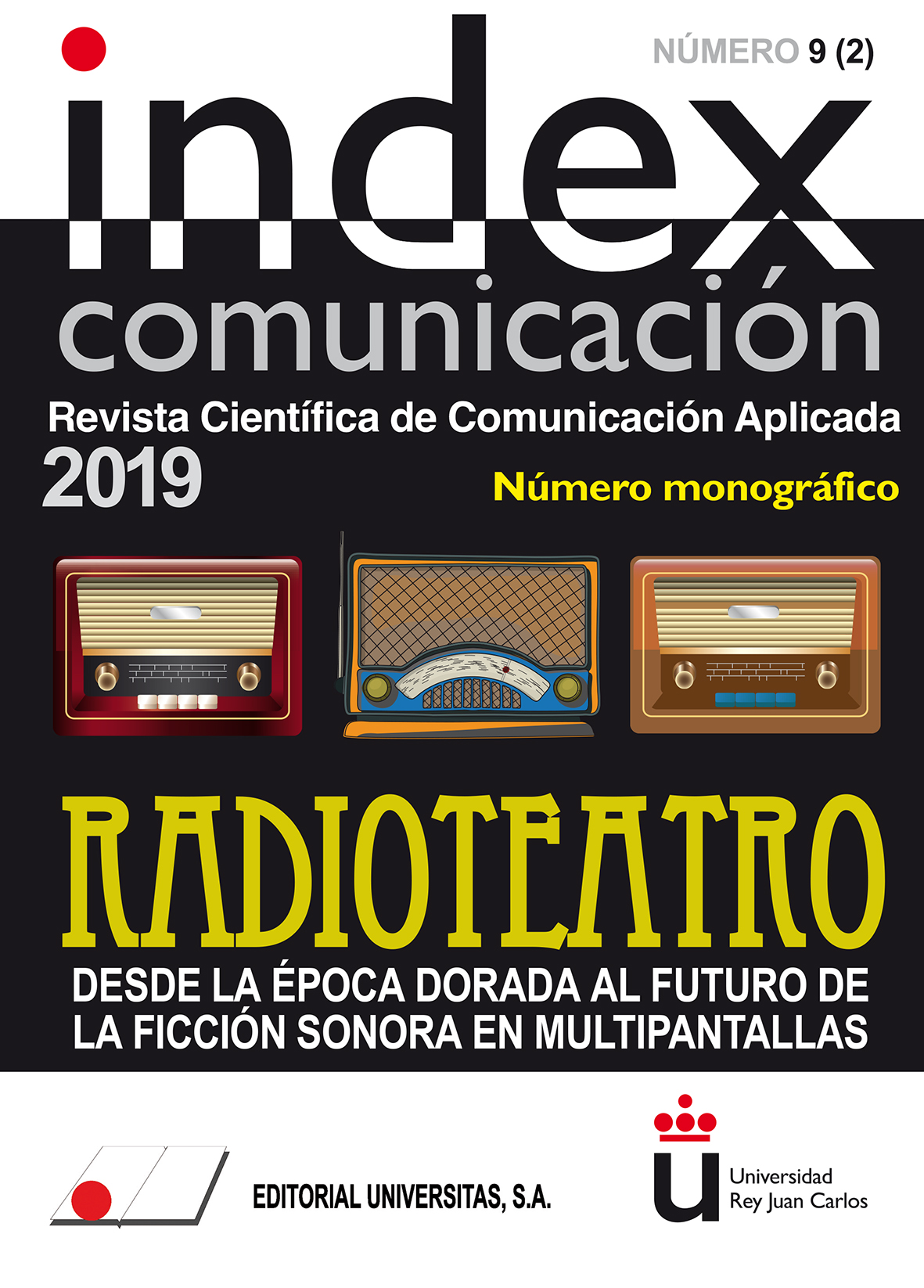Life Stories Reports as a Starting Point for Dramatized Radio and Non-Fiction 'Podcast' in Digital Ecosystem. Case Study: ‘Sin mi Identidad’ (Cadena Cope), ‘Lo Conocí en un Corpus’ (Podium Podcast) and ‘Las Tres Muertes de mi Padre’ (Cuonda)
DOI:
https://doi.org/10.33732/ixc/09/02ElrepoKeywords:
Docudrama, Podcast, Radio, Digital Radio, Radio Drama, Radio Reports,Abstract
In current digital ecosystem, sound is gaining prominence through new formats such as podcasting, born in the era of mobility. Formats that can share elements, characteristics, dynamics of work and consumption with other traditional radio formats, such as reports, docudramas or the radio soap opera. This article aims to analyze whether the strength of human reach storytelling is a common starting point in analogic reports and in fictional and non-fiction podcasts, both on audio platforms and on conventional radio. For this, three podcast are proposed as case study: ‘Sin mi identidad’ (2018, COPE network), ‘Lo conocí en un Corpus’ (2017, Podium Podcast) and ‘Las tres muertes de mi padre’ (2017, Cuonda). The methodology is classified as descriptive and qualitative and includes semi-structured interviews with key subjects in the process of the three spaces considered as objects of study. In the analyzed cases it can be stated that, although reports and fiction and nonfiction podcasts are different products, they share similarities of production, documentation and recording. Also, all have as starting point a real story, even when podcasts are fiction.Metrics
References
ALCUDIA BORREGUERO, M.; BARCELÓ UGARTE, T. y LEGORBURU HORTELANO, J. M. (2012). Convergencia de medios: Nuevos desafíos para una comunicación global. Madrid: CEU Ediciones.
AIMC (2019). Marco general de los medios en España. Recuperado desde: https://www.aimc.es/a1mc-c0nt3nt/uploads/2019/01/marco19.pdf
AIMC (2019b). Navegantes en la Red- Encuesta AIMC a usuarios de Internet. Recuperado desde: https://www.aimc.es/otros-estudios-trabajos/navegantes-la-red/
CAMPOS FREIRE, F. (2011). El nuevo escenario mediático. Sevilla, Zamora: Comunicación Social.
CEBRIÁN HERREROS, M. (1992). Géneros informativos audiovisuales: Radio, televisión, periodismo, gráfico, cine, vídeo. Madrid: Editorial Ciencia.
CORBETTA, P. (2007). Metodología y técnicas de investigación social. Madrid: McGraw-Hill Interamericana.
EBU (2019). Discurso de Noel Curram el Día de la radio. Recuperado desde: https://www.ebu.ch/news/2019/noel-curran-radio-days-europe-speech
ESPINOSA DE LOS MONTEROS, M. J. (2019). Entrevista personal (10 de abril) sin publicar.
GUARINOS, V. (1999). Géneros ficcionales radiofónicos: Revisión de conceptos y propuestas de una nueva tipología. Sevilla: MAD.
HOFFER, T. W. y NELSON, R. A. (1978). Docudrama on American Television. Journal of the University Film and Video Association, 30(2), 21-27.
IDROVO-CARLIER, S. (2001). El secreto está en el relato: fortalezas y retos del docudrama en la era posmoderna. Communication & Society, 14(2), 37-70.
LIPKIN, S. N. (2002). Real emotional logic: Film and television docudrama as persuasive practice. Southern Illinois: University Press.
LÓPEZ TRUJILLO, N. (2019). Entrevista personal (4 abril) sin publicar.
MARTÍNEZ-COSTA, P. (2017). Seis razones para seguir creyendo en la radio. Recuperado desde: https://medium.com/@mpmarcosta/seis-razones-para-seguir-creyendo-en-la-radio-af3b349cfb72
MARTÍN VIVALDI, G. (1992). Curso de redacción: Teoría y práctica de la composición y del estilo: del pensamiento a la palabra. Madrid: Paraninfo.
MARTÍNEZ OTÓN, L. (2019). El uso del reportaje como formato en el nuevo discurso radiofónico. De la radio analógica informativa a la radio online en la Cadena COPE. Los casos de Mediodía COPE y La Linterna (2014-2017). Tesis doctiral no publicada. Universidad CEU San Pablo.
MUÑOZ, B. E. F. (2014). La producción de dramatizados radiales: una visión desde la cultura del trabajo. Revista Latina de Comunicación, actas del VI Congreso Internacional Latina de Comunicación Social.
ORRANTIA, A. (2019). Entrevista personal (10 de abril) sin publicar.
PAGET, D. (1998). No other way to tell it: Dramadoc/docudrama on television. Manchester: Manchester University Press.
PÉREZ-ALAEJOS; M.; PEDRERO-ESTEBAN, L. M. y LEOZ AIZPURU, A. (2018). La oferta nativa de podcast en la radio comercial española: Contenidos, géneros y tendencias. Fonseca, Journal of Communication, 17, 91-106.
PÉREZ CALDERÓN, M. y FERNÁNDEZ ASÍS, V. (1970). La información audiovisual. Madrid: Escuela Oficial de Radiodifusión y Televisión.
RAVENTÓS MERCADÉ, C.; TORREGROSA PUIG, M. y CUEVAS ÁLVAREZ, E. (2012). El docudrama contemporáneo: rasgos configuradores. Trípodos, 1(29), 117-132.
RODERO ANTÓN, E. (2004). La caja de los sueños: Un recorrido por el serial radiofónico en España. Salamanca: Universidad Pontificia de Salamanca.
RODRÍGUEZ PALLARÉS, M. (2017). Reutilización de la ficción sonora en la Cadena SER. El caso de Podium Podcast. Área Abierta. Revista De Comunicación Audiovisual y Publicitaria, 17(1), 83-97.
ROMERO, P. (2019). Entrevista personal (2 de abril) sin publicar.
ROSENTHAL, A. (1999). Why docudrama?: fact-fiction on film and TV. Carbondale: SIU Press.
SANTOS DÍEZ, M. T. (2003). Periodismo radiofónico. Bilbao: Universidad del País Vasco Servicio Editorial.
SÁNCHEZ SERRANO, C. (2017) La radio en tiempos de la posescucha. Recuperado desde: https://medium.com/@Cheloradio/la-radio-en-tiempos-de-posescucha-90c37344b2d4
VALLÉS, M. S. (2014). Entrevistas cualitativas (2º ed.). Madrid: CIS.
Published
How to Cite
Issue
Section
License
Copyright (c) 2019 Laura Martínez Otón

This work is licensed under a Creative Commons Attribution-NonCommercial 4.0 International License.
Authors who submit to this journal agree to the following terms:
Authors retain copyright and ensure the magazine's right to be the first publication of the work as licensed under a Creative Commons Attribution-NoComercial 4.0 International License that allows others to share the work with an acknowledgment of authorship of the work and the initial publication in this magazine, with no commercial purpose.
Authors can establish separate additional agreements for non-exclusive distribution of the version of the work published in the magazine (for example, to an institutional repository or publish it in a book), with an acknowledgment of its initial publication in this journal.
It allows and authors are encouraged to disseminate their work electronically (eg, in institutional repositories or on their own website) prior to and during the submission process, as it can lead to productive exchanges, as well as a citation more early and most of the published work (See The Effect of Open Access).















